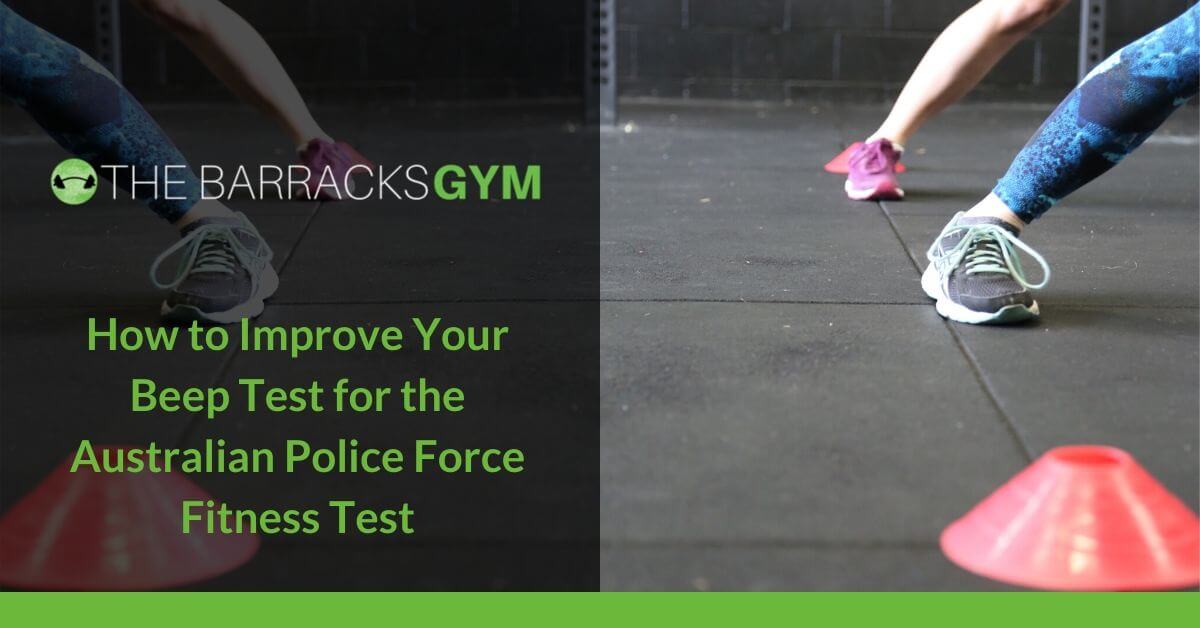|
The Police Force in most Australian states and territories require new applicants to complete the shuttle run test. If that's the case in your area, you will need to prepare yourself to meet those requirements, and you'll only have one attempt on the day. Many of The Barracks Gym members dread the beep test the most and rightly so. It's designed to challenge your fitness and endurance so it should push you to your limits. However, with the right preparation, you can make sure you do not fall victim to this test. Let's see what the beep test is about and how to tackle it with confidence. The Basics - What is the Beep Test? The beep test is also known as the shuttle run or the multi-stage fitness test. It is designed to measure your VO² max or cardiovascular fitness and endurance level. It's carried out over a 20-metre course, which is marked with witches' hats or lines. Applicants will need to run continually between the markers. The shuttle runs are synchronised with a pre-recorded audio track that makes a beep sound in between every internal. The interval between every beep decreases as the task continues, encouraging you to speed up gradually and become faster the longer you are performing the test. You will start the beep test with a five-second countdown. It's recommended you start running at a more comfortable speed to the opposite end of the course, placing at least one foot behind or on the line before the beep sound. At each end, you will need to pivot. You will receive a warning if you do not touch the line or you run in U-turns or semi-circles. You will only be allowed one warning. After this, you will not be able to complete the test if you make the same mistake again. The test is progressive and maximal. You will have to keep going until you don't make it to the marker before the next beep. Your score then will be recorded as the level you achieved before you stopped the test. You are only allowed one attempt at this test. Check the requirements of your territory's police force to understand how much you need to improve to pass. Why Do You Need to Train for the Beep Test?The beep test will be almost impossible to pass if you do not train for it. Firstly, you need to understand your own body and where it stands in terms of endurance, aerobic and anaerobic fitness. You will also need to establish your starting pace as well as the speed you need to run in each section to make it to the cone before the beep but also not to kill yourself too soon. You may think that you are not going to be running for long, but it takes exceptional cardio fitness and concentration to ensure that you perform this task in the right way and that you pace yourself properly so that you do not burn out too soon. Plus, there are no second chances, so it's not a wise idea to go into the test without any practice. Why Shouldn't You Use the Test for Training?The name says it all. The Beep Test is a way to assess your fitness, not an approach you can use to improve the competence required to improve your test results. There are many reasons why it is not considered a training exercise. Firstly, the amount of effort you need to put into the test will gradually increase, so the first part is just like a warm-up. If you'd like to be able to keep up when the pace gets faster, you'll have to work on your aerobic capacity and other elements of endurance in your training. Repeating the beep test over and over won't help with that. If you are fit and have been training hard, you should be able to pass the test. Putting yourself through the test from time to time will help you to get the pace right, and so you know what to expect before the assessment day. How to Train for the Test?You should focus on speed and interval training if you want to ace this test. At The Barracks Gym, we concentrate on 1km, 800m, 400m, and 200m interval training with our members. Fartlek training is also an excellent method to keep your training varied and still working on those fitness goals. The way we practice Fartlek training is 30 seconds of hard pace and then 30 seconds of relaxed pace, with ten repetitions of this. We also recommend distance jogging and trying Maximal Aerobic Speed (MAS) Training. What to Do on Assessment Day?Finally, let's take a look at some of the things you should remember during the test to give yourself the best chance of passing.
Wrapping UpYou may think that passing the beep test is going to be a breeze. However, if you have not done any training or practice in the build-up, then you are likely going to find it very difficult.
There are two main reasons you could fail the shuttle runs: lack of aerobic fitness and endurance and failing to hit the right pace in every section. You can avoid both of these if you train appropriately so jump on our 2 Week Trial and come learn our secrets.
0 Comments
Leave a Reply. |
Most PopularTrusted PartnerWe work with the best service provider for Defence and First Responders.

Get SocialCategoriesArchives
January 2024
|
© COPYRIGHT 2024. ALL RIGHTS RESERVED.


 RSS Feed
RSS Feed